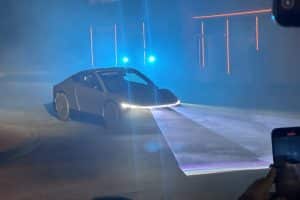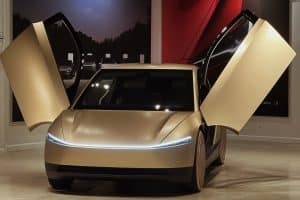- 🚗 The Tesla Cybercab fleet operated autonomously at the “We, Robot” event using near-production AI software.
- 🤖 A total of 19 Cybercabs and 29 Model Ys completed 1,300 trips over 3.5 hours, serving more than 2,000 attendees.
- 🚀 The autonomy was achieved with AI software expected to be released in FSD V13, set for launch this October.
- 👥 Attendees quickly adapted to the autonomous vehicles, treating them like human-driven cars.
- 🧠 Elluswamy praised the Tesla AI team for their effort and success, generating excitement within the electric vehicle community.
In a historic leap towards a fully autonomous future, Tesla recently showcased its Cybercab fleet at the “We, Robot” event, leaving attendees and automotive enthusiasts in awe. This blog post delves into this groundbreaking development, exploring the technological innovations and potential impact on urban mobility.
The Unveiling of Tesla’s Cybercab Fleet
At the “We, Robot” event, Tesla demonstrated its technological prowess with the Cybercab fleet operating autonomously, reliant on near-production AI software. This landmark presentation included a total of 19 Cybercabs and 29 Model Ys, which together executed 1,300 trips over a period of 3.5 hours, efficiently transporting more than 2,000 attendees within the venue.
A Technological Marvel: FSD V13
The success of the Cybercab operation was predominantly due to an advanced AI software, a near-production Full Self-Driving (FSD) technology expected to debut in its 13th version this October. The anticipation surrounding FSD V13 stems from its promise to deliver unprecedented autonomous navigation capabilities, significantly progressing Tesla’s aspiration for a vehicular future free from human intervention.
Observing Attendee Interaction with Autonomous Vehicles
One of the most compelling aspects of the event was observing how attendees interacted with the autonomous Cybercabs. It was noted that the guests quickly adapted to the presence of these autonomous vehicles, showcasing a remarkable level of comfort and trust. This natural acceptance hints at an optimistic future where autonomous vehicles seamlessly integrate into daily life, akin to interacting with human-driven cars.
Insights and Praises from Industry Leaders
Tesla’s Director of Autopilot Software, Ashok Elluswamy, commended his team for their remarkable efforts in bringing this vision to life. The accomplishment was not just a technological triumph but also a testament to the team’s dedication, fueling excitement across the electric vehicle community.
The Road Ahead
The introduction of Cybercabs is not just a testament to Tesla’s innovative spirit but is representative of the broader shift towards autonomous, sustainable urban transportation. With the forthcoming release of FSD V13, there is a palpable excitement about the possibilities it represents for urban mobility.
Conclusion
Tesla’s Cybercab fleet is a harbinger of the future of transport, an era marked by safety, efficiency, and convenience. As technological advancements in autonomous vehicles continue to accelerate, the vision of traffic systems that include Cybercabs seamlessly integrated into everyday life inches ever closer.





